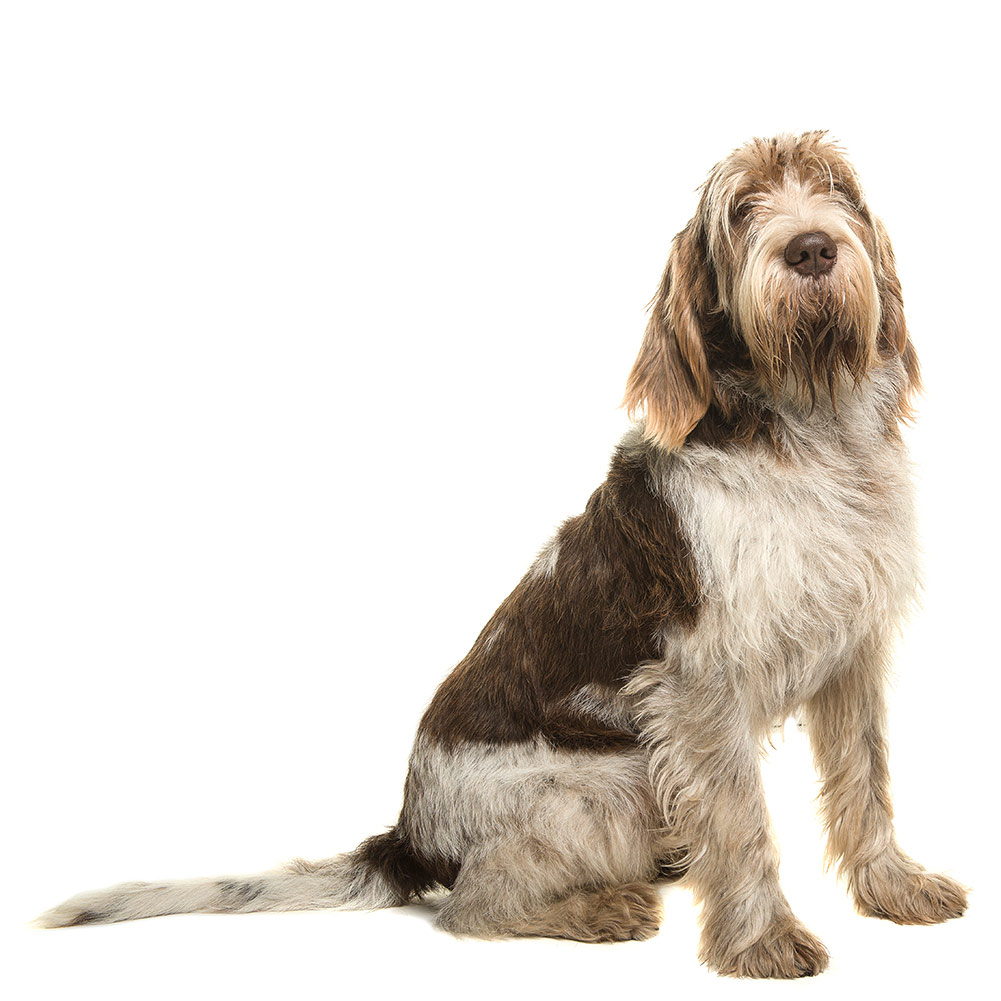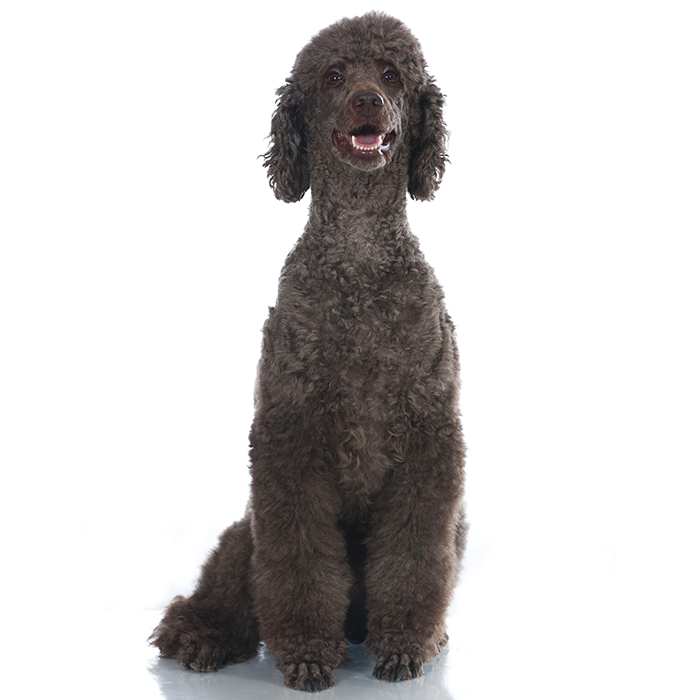Rottweiler


| Recommended for | Active individuals and families |
| Breed Classification | Working group |
| Other names | Rottie |
| Lifespan | 8 - 10 years |
| Size | Large |
| Temperament | Loyal, protective |
| Intelligence | Very high |
| Tendency to bark | Low |
| Maintenance Level | Medium |
| Health Risk | High probability of health issues during its lifetime, hence it is one of the more expensive breeds to insure. |
Insuring a Rottweiler?
Get award-winning cover with more benefits and up to 80% of eligible vet bills reimbursed. Find out about your cover options.
Get a quick quote
Is this breed right for you?
Try our breed selector quiz to find out your best matching breed!
Insuring a Rottweiler?
Get award-winning cover with more benefits and up to 80% of eligible vet bills reimbursed. Find out about your cover options.
Get a quick quote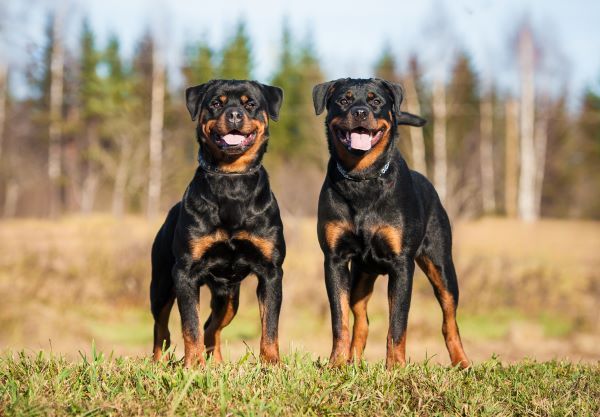
Breed history of Rottweilers
Considered to be one of the oldest dog breeds, the Rottweiler is thought to date back to the Roman Empire. During their conquests, Roman soldiers would take herds of cattle with them in order to have a source of fresh food. Dogs that became the ancestors of today’s Rottweilers were brought along to herd the cattle and keep watch during the night.
Around the 1st century, the Romans and their drover dogs made their way to Germany. The Romans were driven out but their dogs remained, becoming the foundation stock for many German breeds. The Roman dogs were put to work in the the town Rottweil, droving cattle to the market and protecting them from thieves and other animals.
During the Middle Ages, butchers made use of these dogs at the markets. They tied money pouches around their dogs’ necks, effectively keeping robbers at bay, earning them the name “Butcher’s Dog of Rottweil”.
Once railroad cattle cars were introduced in the 1800’s, the need for Rottweilers to drive cattle declined and their numbers diminished greatly. However, the years leading up to World War I saw a resurgence of the breed in which they were used as police dogs, guard dogs, messengers and ambulance dogs. Today the Rottweiler is often used as a guide dog, guard dog, police dog, and search & rescue dog.
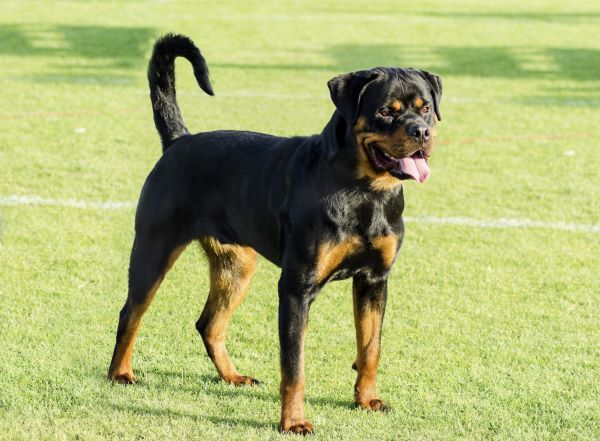
Physical description of Rottweilers
Rottweilers are well-proportioned, large sized working dogs renowned for their compact, muscular build, great strength, agility and endurance. Males are larger and heavier than females.
The Rottweiller’s head is broad, as is their nose. Their dark brown eyes are almond shaped, while their medium sized, triangular ears are set high and wide apart on the head.
The Rottweiler coat is straight, flat and coarse, of medium length. The coat colour is black with well-defined tan or reddish-brown markings on the cheeks, muzzle, throat, chest and legs, as well as over both eyes and under the base of the tail.
| Weight range | Males 50 to 60 kg; females 35 to 48 kg |
| Height range | Males 61 to 69 cm, females 56 to 63 cm |
| Colours | Black with tan, rust or mahogany |
| Coat length | Medium |
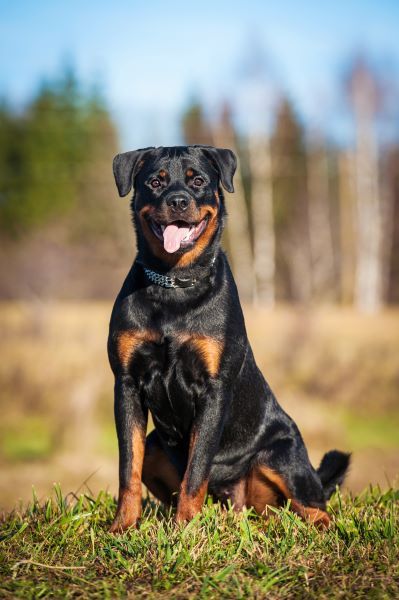
Rottweiler personality and temperament
In general, Rottweilers are good-natured, calm, loyal and obedient dogs and fiercely loyal companions. Devoted to their owners, they will follow you around as they want to be close to you, not left out alone in the yard.
Rotties have an incredibly goofy side. They are an extremely affectionate breed who often forget how big they are and have no worries climbing on their owner’s lap and pretending they’re smaller. Though clownish and playful around family and friends, they are protective of their “pack” and territory, and are very aloof towards and wary of strangers until introduced.
Known for their outstanding work ethic, Rotties are self-assured, steady and fearless. They are also highly alert and protective of their people, making them popular guard dogs.
Despite some negative publicity in the media, Rotties are not generally dangerous dogs. Aggression in the breed usually stems from poor breeding, abuse, neglect or irresponsible ownership. If the Rottweiler is well-trained and socialised with other people and animals from a young age, aggression should not be an issue. Nevertheless, they are recommended for experienced owners as they will test their status in the “pack” and require firm leadership and clear boundaries.
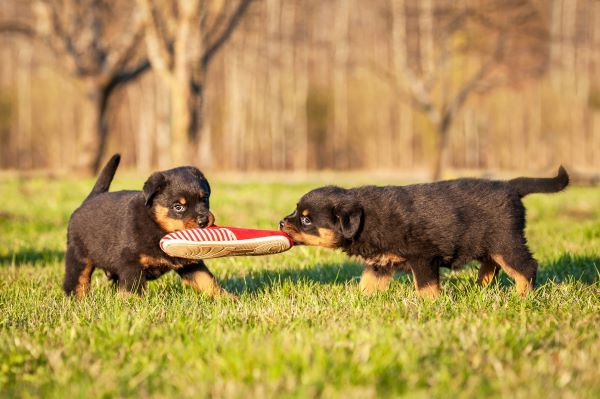
Rottweilers with kids and other pets
The Rottweiler is considered to be a good family dog who makes a great playmate for older children. Playful and silly around their loved ones, they have a patient and gentle demeanor with kids.
Because of their size and strength, careful supervision is required with young children and care should be taken with unfamiliar children, as the Rottie might believe they are a threat to “their” little ones.
Care should also be taken with other pets, although most Rotties get on with other dogs, provided they have been well-socialised from a young age.
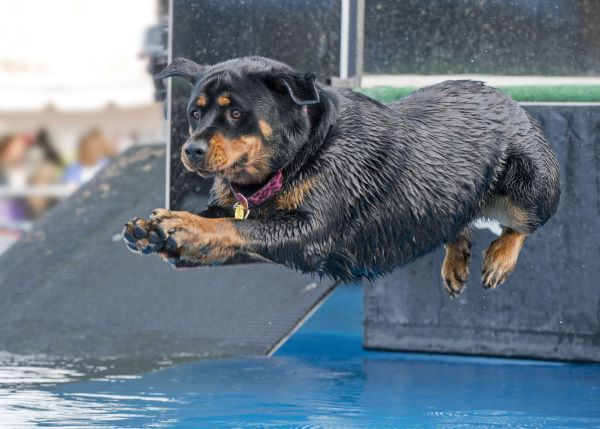
Rottweiler training and exercise
As a big, energetic dog, the Rottie is suited to active individuals and families who have enough time to give their dog an adequate amount of exercise. Rotties need at least one walk per day, but they also love swimming and jogging with their people, and excel at dog sports such as herding, tracking, carting and obedience.
Rottweilers must be trained and socialised from early on in order to be a well-mannered and well-behaved dog. Highly intelligent, Rotties are very trainable and eager to please, although they can sometimes be stubborn. They require firm, fair and consistent discipline from an experienced owner. Aggression can occur if the Rottweiler experiences abuse, neglect or irresponsible ownership.
| Energy level | High |
| Exercise requirements | High |
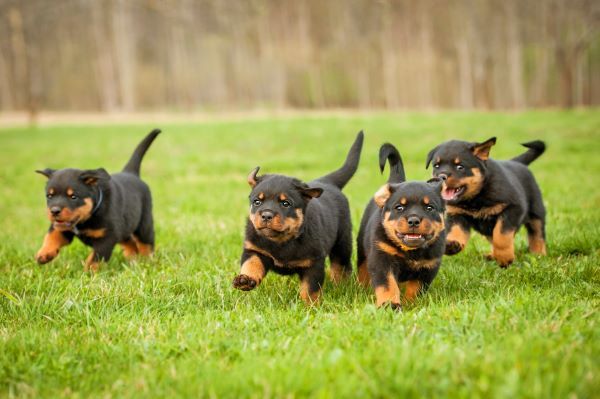
Rottweiler feeding and nutrition
The Rottweiler should be fed a premium, high-quality dog food appropriate to the dog’s age (puppy, adult, or senior), size and activity level. To aid a healthy growth and prevent problems in later years, puppies require a specially formulated diet, with higher protein, fat, calcium, and other vitamins and minerals.
Rottweilers that aren’t sufficiently exercised or overfed may become overweight, so watch your dog’s calorie consumption and weight level and don’t overindulge in the treats department.
Check with your vet if you have any concerns about your Rottweiler’s weight or diet.

Rottweiler care and grooming
Rotties are moderate shedders for most of the year, and more profuse shedders twice a year, usually in spring and autumn. They should be brushed weekly to remove loose hair and distribute natural oils through the coat, and bathed monthly, or more often if they become very dirty.
Check the Rottie’s ears regularly to ensure they are clean and have no discharge, and clip their nails as required.
Health issues for Rottweilers
- Hip and elbow dysplasia are common conditions, particularly in large and giant breeds, in which the ball and socket of the affected joint do not fit together properly. Rottweiler breeders should have the hips and elbows of all breeding stock x-rayed and analysed regularly by a specialist and be able to provide paperwork to that effect.
- Osteochondritis dissecans, which affects the shoulders, can also be a problem for Rottweilers because of their fast growth rate. It is caused by inflammation and lesions in the shoulder joints, causing swelling, irritation and pain. Symptoms include limping, favouring one paw, swelling and pain when extending a joint. Surgical and conservative treatment options are available.
- Cancer is among the most common causes of early Rottweiler death, and this breed is more susceptible than others. Osteosarcoma, an aggressive bone cancer, is one of the most common cancers in Rottweilers. The first sign is lameness, but x-rays are needed to determine if cancer is the cause. If so, it is treated aggressively, often with chemotherapy and amputation.
- Parvovirus is a highly contagious disease responsible for the deaths of many puppies and young dogs, but which can be prevented with a vaccine. Rottweilers are prone to parvovirus infection. It has an 80% fatality rate and can kill within days of infection. Symptoms include loss of appetite, depression, fever, dehydration, lethargy, bloody diarrhoea and serious vomiting.
- Obesity can result from overfeeding and under-exercising the Rottweiler, and this in turn can cause serious health issues such as arthritis, breathing problems, diabetes, heart failure, skin disease and a compromised immune system.
- Breeders should have certificates indicating that their dogs have a full and complete dentition with a scissor-bite and do not have the eyelid abnormalities entropion or ectropion.
Not all conditions are covered by Pet Insurance. For details of Bow Wow Meow Pet Insurance cover, refer to the Product Disclosure Statement.
What do Rottweiler owners claim for the most?
- Cruciate Disease
- Otitis Externa
- Gait Abnormality
- Mass Lesion
- Dermatitis
Thinking about insuring a Rottweiler
Thinking about insuring a Rottweiler
Learn moreThinking about insuring a Rottweiler
Learn moreFree engraved pet ID tag on sign up3
Customer Satisfaction
21 day cooling off
Life-long cover4

GapOnly® & easy claims
Further Information:
National Rottweiler Council of Australia: http://www.nationalrottweilercouncil.com/
Rottweiler Club of New South Wales: http://www.rcnsw.com.au/
Rottweiler Club of South Australia Inc: http://www.rottweilerclubsa.com.au/
Rottweiler Club of Victoria Inc: http://www.rottweilerclubofvictoria.com/
Rottweiler Club of Queensland Inc: http://www.rcqld.net/

